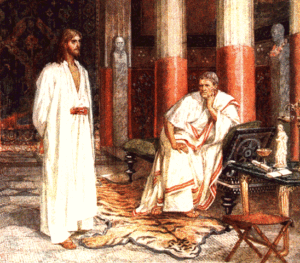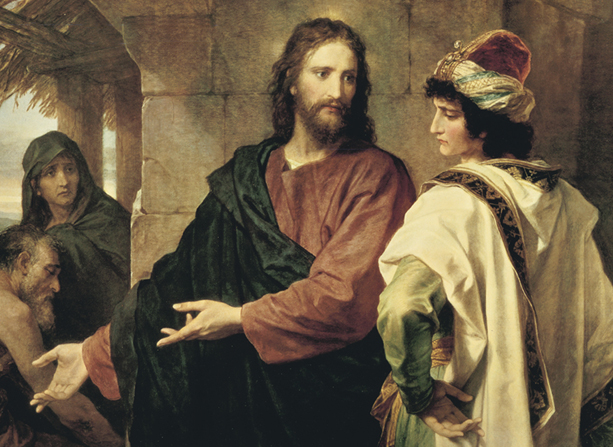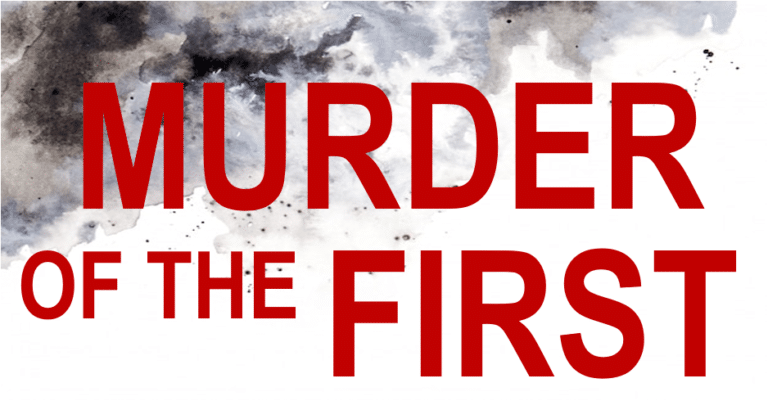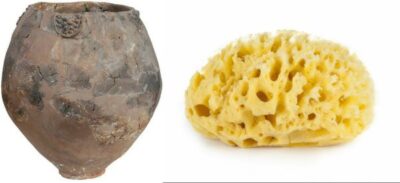“Slain from the foundation of the world.” (Revelation 13:8)
‘Slain from the foundation of the world’ is a concise and perfect description of the prophetic path of Jesus’s earthly life, beginning with His miraculous birth and ending with His death on the cross.
God sent His Son, born of a woman, to an earthly life for one purpose and one predetermined end. His life would not consist of events we’d find in a typical man’s life; it would begin with an obscure birth in squalled conditions and end in a horrible public execution: death by crucifixion. His predetermined death was more than a death; it was a sacrifice. A sacrifice only He could make, not for His guilt, but ours. Without the ‘sacrifice’ of Jesus, humanity would be without any chance of redemption.
The prophetic path summarized in Revelation 13:8 begins in Genesis and ends at Calvary. For our purposes in this article, we will not start with the messianic prophecies found in Genesis, even though I will refer back to some of them. Our journey will begin with the miracle of our Savior’s birth and end with His sacrifice. I hope from this we can start to comprehend how great a gift He had given us. It begins with His inception.
“Mary said to the angel, how can this be, since I am a virgin? The angel answered and aid to her, the Holy spirit will come upon you, and the power of the Most High shall overshadow you; and for that reason the holy child shall be called the Son of God.” (Luke 1:34-35).
I cannot begin to imagine how Mary, the mother of Jesus, must have felt or dealt with God choosing her to give birth to the Savior of humanity. Because of her choosing, she is forever ‘blessed among woman.’ We recognize the honor of God’s gift to Mary; a gift never again is given to any woman after her. However, we tend to overlook the inherent dangers that accompany this honor. The social atmosphere of her day would consider a pregnant unwed mother anything but blessed. In fact, because of her betrothal, her pregnancy could cost her her life.
Born of a virgin is our first stop.
Some deny the virgin birth. Those who deny the virgin birth concede with some reluctance that Jesus was a good man but created by typical human conception. Others say God chose Jesus to do his work shortly after His baptism. And others say Jesus was just a prophet. None of these positions could or would meet the qualifications as an acceptable sacrifice for sin. Only a virgin birth would be an acceptable sacrifice for our sins since we were born in sin
after Adam.
The acceptable sacrifice for sin is: “your lamb shall be an unblemished male a year old.” (Exodus 12:5). Because everyone born of man is not without sin (blemish), only a virgin birth could produce a lamb (man) without blemish.
Mary would be overshadowed or be with child by the Holy Spirit. The Holy Spirit of God is without sin; hence the child conceived in Mary’s womb would be a lamb (man) without blemish (sin) and an acceptable sacrifice for sin.
The second requirement of an acceptable sacrifice to God is “Sanctify to Me every firstborn, the first offspring of every womb among the sons of Israel, both man and beast; it belongs to Me.” (Exodus 13:1). So Jesus also had to be Mary’s firstborn. Once she gave birth to other children by relations with Joseph, she could never again have a child without blemish.
The virgin birth of Jesus is foretold in the prophecy of Isaiah “Therefore the Lord Himself will give you a sign: Behold, a virgin will be with child and bear a son, and she will call His name Immanuel.” (Isaiah 7:14). Those who deny the virgin birth of Jesus use this verse in Isaiah to refute it, claiming the actual verbal rending is ‘young maiden’ and not a virgin.
The use of ‘young maiden‘ does not refute ‘virgin,’ it is perfectly synonymous. I’ll show you why. It begins with betrothal.
In today’s society, we think of betrothal as engaged. Our concept of engagement is a verbal commitment to a future with one’s partner, finalized and legally binding upon consummation. The seriousness of engagement in Mary’s day was far different.
A betrothed woman is legally married in Jewish law. The husband’s family is entitled to any dowry from the bride’s family once the betrothal begins. Likewise, the betrothed bride was entitled to her husband’s property. If Joseph were to die, before consummation of the marriage, Mary would inherit everything belonging to Joseph. Once betrothed, they are legally married for all intents and purposes.
A ‘betrothed’ bride, after female experts physically verified her virginity in the company of the mothers of the bride and groom, she is a be’tultada (maiden). The description maiden only applied to virgin brides.
Mary’s unexplained pregnancy was a severe violation of the betrothal commitment. If she became pregnant by Joseph before the official ceremony, the pregnancy would have been frowned upon; but to show up with a child, not by her future husband, was a violation potentially punishable by death. Death by stoning.
Thankfully, the Holy Spirit intervened in the lives of Mary and Joseph and gave them the foresight to recognize the importance of the birth of this child, despite the way others looked upon them. To their friends and both families, this was an unwanted child conceived outside traditional normalcy boundaries. Both parents would be looked down upon and shunned because of these events. The child’s salvation came about by the very law this pregnancy seemed to violate.
Since betrothed, Mary’s denouncement, legal charge, and sentence were solely at Joseph’s discretion. Betrothal meant Joseph alone could legally decide Mary’s fate. The same Holy Spirit which made Mary’s inception possible instructed Joseph on the necessity of this child’s birth.
Joseph, warned in a dream, was told what he must do, what this child’s name was to be, and what His mission would be; “She will bear a Son: and you shall call His name Jesus, for He will save His people from their sins.” (Mathew 1:21). So the lamb’s journey, slain from the foundation of the world, would begin as an unwanted child. Unwanted by those He came to save through his sacrifice.
A virgin birth as foretold in Isaiah 7:14 “Behold, a virgin shall be with child and bear a son and she will call his name Immanuel.”
The next stop in the prophetic trail of this sacrificial lamb would be the location of His birth. Since Joseph and Mary lived in Nazareth at the time, and Nazareth was not the prophetic location of the child’s birth, changes would come, and come they did.
In Luke 2:1, the Roman government ordered a census taken, probably, for taxation purposes. The census required everyone to return to their family’s origin’s city (or territory). This requirement meant that Joseph and Mary would have to leave Nazareth and go to Bethlehem, Joseph’s family home, pregnancy notwithstanding.
Bethlehem would be both Jesus’s place of birth and a prophetic picture of His end by association. It is not only the location of Bethlehem itself, but what went on there that is key. The area around Bethlehem was set aside for raising sheep, but the sheep raised here were destined for one place and one purpose. Sheep were raised solely for sacrifice on the altar in Jerusalem. Thousands upon thousands of these lambs would be birthed, raised, and then slaughtered in their first year of life.
Stunning. Jesus, the “lamb slain before the foundation of the world,” was born amid the rest of the lambs whose purpose was the same; sacrificed for someone else’s sins. The place of His birth was a picture worth a thousand words. Industry and location serve as an illustration of Jesus’s destiny.
The romanticizing of our Savior’s birth in a rock-hewn stable full of animals, wrapped in clothes, placed in a manger, as Angels announced his birth to humble sheep-herders sitting around a fire is far from factual. I see nothing wrong with these peaceful, innocent depictions of our Savior’s birth, as long as we understand the reality that underpins these events.
Our Savior’s birth is a significant and joyous event and reason for celebration. There is no better way to celebrate His birth than to share the joy of God’s love with others.
The angel’s announcement to the shepherds indicates it was celebrated on earth and in heaven with rejoicing.
And the angelic announcement of Jesus’s birth to the shepherds is not without significance. Our mental picture of shepherds and their profession as one of nobility is not accurate. Shepherds and sheep-herding was an undesirable occupation. In most cases, they were the lowest of the low and avoided by most people. How great is our God? The first people who would hear about the birth of our Savior would be the outcasts of society.
What were those shepherds were doing there was their job. They watched over their flocks from towers specially constructed for this purpose. They were known as sheep towers; In Hebrew, Migdal Eders. Migdal means tower, and Eder means sheep (see image).

In Genesis 35, we find a prophetic and historical connection to Bethlehem and these sheep towers.
“So Rachel died and was buried on the way to Ephrath (that is Bethlehem). Jacob set up a pillar over her grave: that is the pillar of Rachel’s grave to his day. Then Israel journeyed on and pitched his tent beyond the tower of Eder” (Gen. 35:19-21).
These Migdal were stone two-story towers. We see from the Genesis account they have been in use since ancient times. The upper story was an observation deck, usually covered with thatch. And the lower, enclosed area was used as a birthing and nurturing station for sheep. We cannot be 100% sure that Jesus was born in a Migdal, but it is far more likely than the romanticized stable tradition.
And if you prefer the born-in-a-stable tradition, it doesn’t take away from the fact Jesus; the lamb sacrificed for our sins, was born amongst thousands of other lambs destined for sacrifice. I think the belief of the traditional birthplace, being a barn or stable, centered around the word manger, translated as a feeding trough for animals. The original word for a manger in Greek phatne’ is translated as a feeding-trough, manger, or stall. Still, since the term is only used (in its original form) 4 times in the New Testament, it’s likely a general description of an item with several uses.
But a ‘manger’ in a Sheep Tower had a specific function. Baby lambs were very susceptible to self-inflicted injury and hypothermia. So when a ewe was about to give birth, shepherds took the ewes inside the migdal. Once the lamb was born, it was wrapped in swaddling cloths and placed in a manger to keep it warm and from hurting itself. Once calm, the shepherds would take the lamb to the mother for nursing.
The Bible tells us in Luke 2:7, “And she gave birth to her firstborn son; and she wrapped Him in cloths, and laid Him in a manger.” The King James Bible renders the verse “wrapped Him in swaddling cloths.” Swaddling cloths were strips of cloth used to wrap the sheep up. They were inexpensive, possibly scrap clothing, and easier to apply, as anyone who has tried to put an anxious newborn in a jumper will testify.
So Mary wrapped the child and placed him in a manger, using what was on hand and had a more than similar purpose. The place of our Lord’s birth fulfilled several prophecies, but two stand out and mesh beautifully with this point in our prophetic journey. Both from the book of the prophet Micah.
“As for you, tower of the flock, Hill of the daughter of Zion, To you it will come-Even the former dominion will come, The Kingdom of the daughter of Jerusalem” (Micah 4:8).
“But as for you, Bethlehem Ephrathah, Too little to be among the clans of Judah, From you One will go forth fro Me to be ruler of Israel. His goings forth are from long ago, From the days of eternity.” (Micah 5:2).
One can not help but take note of the sections “tower of the flock” and “His goings forth are from long ago, From the days of eternity” in these two passages. While I can see no issue with the heartwarming traditional depiction of the birth of Christ in a stable with farm animals, I must say that representation is for children and Christians who are still babes in the faith.
Those grown in the faith need to accept this entire chain of events surrounding the birth of our Savior as they indeed are. A lamb born for one purpose -to be the sacrifice for our sins. A sinless offering, without blemish, born in the same conditions as every other lamb bound for Temple sacrifice in Bethlehem.
I can never be worthy of what God’s Son, the Savior of humanity, my Savior, went through being born in such a place under such conditions.
End of Part One.










+ There are no comments
Add yours